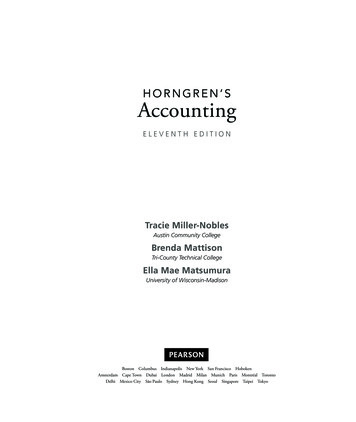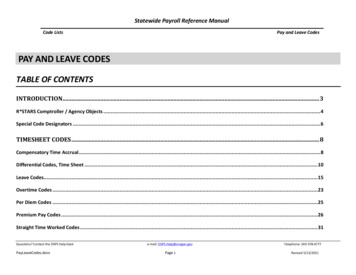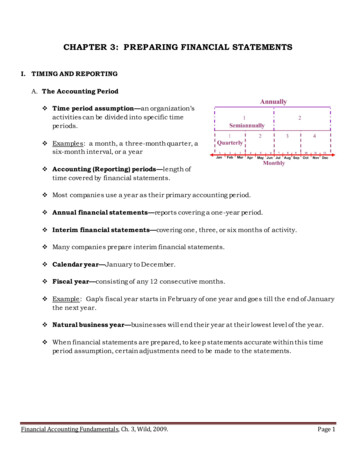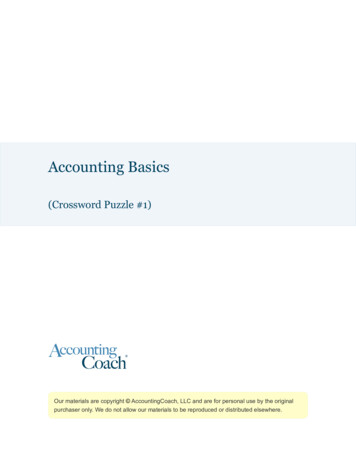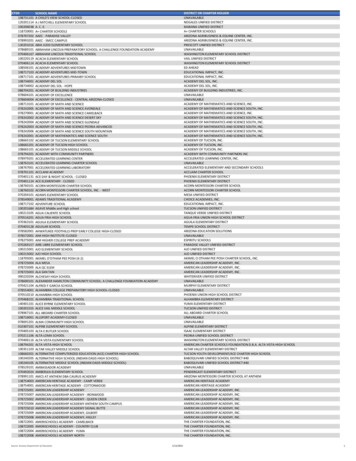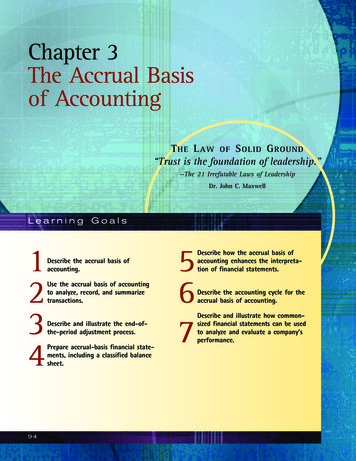
Transcription
Chapter 3The Accrual Basisof AccountingT HE L AW OF S OLID G ROUND“Trust is the foundation of leadership.”—The 21 Irrefutable Laws of LeadershipDr. John C. MaxwellLearning Goals123494Describe the accrual basis ofaccounting.Use the accrual basis of accountingto analyze, record, and summarizetransactions.Describe and illustrate the end-ofthe-period adjustment process.Prepare accrual-basis financial statements, including a classified balancesheet.567Describe how the accrual basis ofaccounting enhances the interpretation of financial statements.Describe the accounting cycle for theaccrual basis of accounting.Describe and illustrate how commonsized financial statements can be usedto analyze and evaluate a company’sperformance.
95Wendy’sWendy’s was founded by Dave Thomas in 1969 in Columbus, Ohio, and was named afterDave’s daughter. In 2001, Wendy’s International had sales of 2.3 billion. Wendy’s market share of approximately 13 percent is third behind McDonald’s 43 percent and BurgerKing’s 19 percent. Wendy’s has over 40,000 employees and 6,000 restaurants.Wendy’s operating philosophy is influenced by Dave’s background. Growing up, Daveworked as a paperboy, golf caddy, grocery deliverer, and bowling alley pinsetter. Later,he enlisted in the Army, where he served as a manager of the Enlisted Men’s Club. Eventually, he returned to Columbus, Ohio, where he helped a former boss turn around aKentucky Fried Chicken franchise that had been losing money. In 1968, he sold hisownership interest in the KFC franchise to fulfill his life-long dream of opening his ownrestaurant.How did Wendy’s succeed in the highly competitive fast-food industry? First, Dave wasinnovative. His first restaurant featured a salad bar. This was a radical change in the fastfood industry. Second, Dave tried to create a family-friendly atmosphere in his restaurantsby decorating with glass lamps and bentwood chairs. Third, Dave emphasized the importance of making each sandwich fresh, never frozen, and offering customers a choice oftoppings. Finally, a highly successful series of advertising campaigns significantly contributed to Wendy’s success.The premise behind Wendy’s advertising was an emphasis on food and quality. One ofWendy’s most successful advertising campaigns appeared in the mid-1980s, using the slogan, “Where’s the beef?” However, the advertising campaigns that established Dave Thomasas a household name were the campaigns that featured him cooking or serving hamburgers. Sales increased dramatically as the ads continued to run, and Dave became an icon.Most advertising executives agree that the success of the ads was due to Dave being a“normal” person and not an actor. One executive, Bob Garfield, commented: “. . . such aperfect symbol of the brand, he represented . . . the perennially bewildered guy with thewan smile who could always take refuge in something real, Wendy’s hamburgers.” Butafter Dave’s death on January 8, 2002, analysts questioned whether Wendy’s success couldcontinue without him.In this chapter, we continue our discussion of financial statements and financial reporting systems. In doing so, we focus on the accrual basis of accounting system that isused by all major businesses, such as Wendy’s. Our discussions will include how to recordtransactions under accrual accounting, how to update accounting records and prepareaccrual-basis financial statements, and how to prepare accounting records for the nextperiod.Source: “Wendy’s Loses Its Legend, “ by Bruce Horovitz and Theresa Howard, USA Today, January 9, 2002; “After Founder Dies, Wendy’sPonders New Ways to Pitch,” by Stuart Elliott, The New York Times, January 9, 2002; “Dave Thomas, 69, Wendy’s Founder, Dies,” byDouglas Martin, The New York Times, January 9, 2002.
96Chapter 3 The Accrual Basis of AccountingYour Need to KnowDo you subscribe to any magazines? Most of us subscribe to one or more magazines suchas Cosmopolitan, Sports Illustrated, Golf Digest, Fly Rod & Reel, Newsweek, Business Week,Barron’s, or People. Magazines usually require us to prepay the yearly subscription pricebefore we receive any issues.When should the magazine record this revenue from subscriptions? As we discussed inChapter 2, under the cash basis of accounting a publisher records the revenue when thecash is received. However, large corporations publish most of the popular magazines. Forexample, AOL Time-Warner publishes over one hundred and thirty magazines includingFortune, Time, Entertainment Weekly, People, and Sports Illustrated. Large corporationssuch as AOL-Time Warner must follow generally accepted accounting principles that require the use of the accrual basis of accounting.In this chapter, we will describe and illustrate how to account for transactions using theaccrual basis of accounting. Under accrual accounting, revenues are recorded when theyare earned, regardless of when the cash is actually received. Thus, AOL-Time Warner recordsrevenues from magazine subscriptions each month as its magazines are published and delivered. Because all large companies use the accrual basis of accounting, a thorough understanding of accrual basis is important for your business studies and future career.The Accrual Basis of Accounting and theMatching Concept1Describe the accrualbasis of accounting.In Chapter 2, we illustrated the use of the cash basis of accounting for Family Health Carefor the months of September and October. In these illustrations, we used many of the accounting concepts we described in Chapter 1. For example, under the business entity concept, we accounted for Family Health Care as a separate entity independent of theowner-manager, Dr. Lee Landry. Under the cost concept, we recorded the purchase of landat the amount that we paid for it. Consistent with the going concern concept, we did notrevalue the land for increases or decreases in its market value, but retained the land inthe accounting records at its original cost. We also employed the accounting period, fulldisclosure, objectivity, and the unit of measurement concepts in preparing financial statements for Family Health Care.The one accounting concept that we did not emphasize in Chapter 2 was the matching concept. This is because we used the cash basis of accounting. Transactions wererecorded only when cash was received or paid. For example, when 6,000 of cash was received for Dr. Landry’s initial investment in Family Health Care, the transaction wasrecorded as an increase in assets (cash) and an increase in stockholders’ equity (capitalstock). Likewise, when 10,000 cash was received from First National Bank as a loan, thetransaction was recorded as an increase in assets (cash) and an increase in liabilities (notespayable). The other transactions were recorded in a similar manner as cash was receivedor paid. This is how individuals normally record transactions. That is, we record only thereceipts and payments of cash in our personal records.Under the cash basis, the matching concept is not emphasized. Rather, the receipt orpayment of cash governs the recording process. Revenues and expenses are matched witheach other only if cash from revenues is received in the same period as cash is paid forexpenses. While the cash basis may work reasonably well for individuals or small businesses, it does not work well for large businesses. This is because the timing of when cashis received or paid can vary widely with the result that net income may become meaningless under the cash basis. For example, a construction company might spend monthsor years developing land for a business complex or subdivision. During the development
97Chapter 3 The Accrual Basis of Accountingof the land, the company would have to pay for materials, wages, insurance, and otherconstruction items. At the same time, cash might not be received until portions of the development are sold. As a result, a series of net losses would be reported during development until some sales occur. Thus, the income statement under the cash basis might notprovide a realistic picture of the company’s operations. In fact, the development might behighly successful and the early losses misleading.The accrual basis of accounting is designed to avoid misleading income statement results that could otherwise result from the timing of cash receipts and payments. At thesame time, the accrual basis recognizes the importance of reporting cash flows throughits emphasis on preparing the statement of cash flows.Under the accrual basis of accounting, transactions are recorded as they occur and thusaffect the accounting equation (assets, liabilities, and stockholders’ equity). Since the receipt or payment of cash affects assets (cash), all cash receipts and payments are recordedin the accounts under the accrual basis or the cash basis. However, under the accrual basis, transactions are also recorded even though cash is not received or paid until a laterpoint. For example, Family Health Care may provide services to patients who are coveredby health insurance. It then files a claim with the insurance company for the payment. Inthis case, the services are said to be provided “on account.” Likewise, a business may purchase supplies from a vendor, with terms that allow the business to pay for the purchasewithin a time period, such as ten days. In this case, the supplies are said to be purchased“on account.” Each of the preceding illustrations represents abusiness transaction that affects elements of the accountingJ. C. Clark, Attorney at Law, draftedequation and is therefore recorded under the accrual basis, evena will and estate documents forthough cash is not received or paid.Max Winder on April 30. ClarkIn accounting, we often use the term “recognized” to referbilled Winder 1,200 for thesetowhena transaction is recorded. Thus, under the cash basisservices on May 20 and receivedofaccounting,transactions are not recognized until cash ispayment on June 4. In what monthreceivedorpaid.Under the accrual basis of accounting, revshould Clark record the revenue underenueisnormallyrecognized when it is earned. For Familythe accrual and cash bases of accounting?Health Care, revenue is earned when services have been provided to the customer. At this point, the revenue earningAccrual basis: April; Cash basis: June.process is complete, and the customer is legally obligated topay for the services.Under the accrual basis, the matching concept plays an important role in determiningwhen expenses are recorded. When revenues are earned and recorded, all expenses incurred in generating the revenues must also be recorded, regardless of whether cash hasbeen paid. In this way, revenues and expenses are matched and the net income or net lossfor the period can be determined. This is an application of the matching concept that weStrategy in BusinessNot Cutting Cornersave you ever ordered a hamburger from Wendy’s andnoticed that the meat pattyis square? The square meat pattyreflects a business strategy instilledin Wendy’s by its founder, DaveHThomas. Mr. Thomas’ strategy wasto offer high-quality products at afair price in a friendly atmosphere,without “cutting corners”; hence,the square meat patty. In the highlycompetitive fast-food industry, DaveThomas’s strategy enabled Wendy’sto grow to be the third largestfast-food restaurant in the world,with annual sales of over 7 billion.Source: “Dave Thomas, 69, Wendy’s Founder, Dies,” byDouglas Martin, The New York Times, January 9, 2002.
98Chapter 3 The Accrual Basis of Accountingdiscussed in Chapter 1. That is, expenses are recognized and recorded in the same periodas the related revenues that they generated.The accrual basis recognizes liabilities at the time the business incurs the obligation topay for the services or goods purchased. For example, the purchase of supplies on accountwould be recorded when the supplies are received and the business has incurred the obligation to pay for the supplies.Using the Accrual Basis of Accounting forFamily Health Care’s November Transactions2Use the accrual basis To illustrate the accrual basis of accounting, we will use the November 2003 Family HealthCare transactions. These transactions are as follows:of accounting toanalyze, record, anda.On November 1, received 1,800 from ILS Company as rent for the use of Familysummarize transactions.b.c.d.e.f.g.h.i.j.k.l.Health Care’s land as a temporary parking lot from November 2003 through March2004.On November 1, paid 2,400 for an insurance premium on a two-year, general business policy.On November 1, paid 6,000 for an insurance premium on a six-month medicalmalpractice policy.Dr. Landry invested an additional 5,000 in the business in exchange for capitalstock.Purchased supplies for 240 on account.Purchased 8,500 of office equipment. Paid 1,700 cash as a down payment, withthe remainder due in five monthly installments of 1,360, beginning December 1.Provided services of 6,100 to patients on account.Received 5,500 for services provided to patients who paid cash.Received 4,200 from insurance companies, which paid on patients’ accounts forservices that have been provided.Paid 100 on account for supplies that had been purchased.Expenses paid during November were as follows: wages, 2,790; rent, 800; utilities, 580; interest, 100; miscellaneous, 420.Paid dividends of 1,200 to stockholders (Dr. Landry).In analyzing and recording the November transactions for Family Health Care, we usethe same format as we used in Chapter 2. In so doing, we record increases and decreasesfor each financial statement element. These separate elements are referred to as accounts.Transaction a On November 1, received 1,800 from ILS Company as rent for the useof Family Health Care’s land as a temporary parking lot from November 2003 throughMarch 2004. In this transaction, Family Health Care entered into a rental agreement forthe use of its land. The agreement required the payment of the rental fee of 1,800 inadvance. The rental agreement also gives ILS Company the option of renewing the agreement for another four months.How does this transaction affect the accounts (elements) of the accounting equationand how should it be recorded? Since cash has been received, cash is increased by 1,800,but what other account should be increased or decreased? Family Health Care has agreedto rent the land to ILS Company for five months and thus has incurred a liability to provide this service—rental of the land. If Family Health Care canceled the agreement on November 1, after accepting the 1,800, it would have to repay that amount to ILS Company.
99Chapter 3 The Accrual Basis of AccountingThus, Family Health Care should record this transaction as an increase in cash and an increase in a liability for 1,800. Because the liability relates to rental revenue, it is recordedas unearned revenue, as shown below.Assets Liabilities Stockholders’ EquityNotesUnearnedCapitalRetainedCash Land Payable Revenue Stock EarningsBal. 7,32012,00010,0006,0003,320a.1,8001,800Received rent in advanceBal. 9,12012,00010,0001,8006,0003,320As time passes, the liability will decrease and Family Health Care will earn rental revenue. For example, at the end of November, one-fifth of the 1,800 ( 360) will have beenearned. Later in this chapter, we will discuss how to record the 360 of earned rent revenue at the end of November.You should note that the beginning balances shown in the preceding equation are theending balances from October. That is, the cash balance of 7,320 is the ending cash balance as of October 31, 2003. Likewise, the other balances are carried forward from thepreceding month. In this sense, the accounting equation represents a cumulative historyof the financial results of the business.Transaction b On November 1, paid 2,400 for an insurance premium on a two-year,general business policy. This umbrella policy covers a variety of possible risks to thebusiness, such as fire and theft. By paying the premium, Family Health Care has purchased an asset, insurance coverage, in exchange for cash. Thus, the mix of assets haschanged. However, the prepaid insurance coverage is unique in that it expires with thepassage of time. At the end of the two-year period, the asset will have completely expired. Such assets are called prepaid expenses or deferred expenses. Thus, the purchaseof the insurance coverage is recorded as prepaid insurance, as shown below.Assets Liabilities Stockholders’ EquityPrepaidNotesUnearnedCapitalRetainedCash Insurance Land Payable Revenue Stock EarningsBal.9,12012,00010,0001,8006,0003,320b. 2,4002,400Paid insurance for two r in this illustration, we will discuss how such accounts are updated at the end ofan accounting period to reflect the portion of the asset that has expired.Transaction c On November 1, paid 6,000 for an insurance premium on a six-monthmedical malpractice policy. This transaction is similar to transaction (b), except thatFamily Health Care has purchased medical malpractice insurance that is renewable everysix months. The transaction is recorded as follows:Assets Liabilities Stockholders’ EquityPrepaidNotesUnearnedCapitalRetainedCash Insurance Land Payable Revenue Stock . aid insurance for 6 months
100Chapter 3 The Accrual Basis of AccountingTransaction d Dr. Landry invested an additional 5,000 in the business in exchangefor capital stock. This transaction is similar to the one in which Dr. Landry initially established Family Health Care. It is recorded as shown below. AssetsLiabilities Stockholders’ EquityPrepaidNotesUnearnedCapitalRetainedCash Insurance Land Payable Revenue Stock ,0005,000InvestmentBal. 5,7208,40012,00010,0001,80011,0003,320Transaction e Purchased supplies for 240 on account. This transaction is similarto transactions (b) and (c), in that purchased supplies are assets until they are usedup in generating revenue. Family Health Care has purchased and received the supplies, with a promise to pay in the near future. Such liabilities that are incurred inthe normal operations of the business are called accounts payable. The transaction is recorded by increasing the asset supplies and increasing the liability accountspayable, as shown below.Assets Liabilities Stockholders’ h Ins. Supplies Land Pay. Pay. Revenue Stock EarningsBal. hase of suppliesBal. ction f Purchased 8,500 of office equipment. Paid 1,700 cash as a downpayment, with the remainder due in five monthly installments of 1,360, beginning December 1. In this transaction, the asset office equipment is increased by 8,500, cash isdecreased by 1,700, and notes payable is increased by 6,800. The transaction isrecorded as follows:Assets Liabilities Stockholders’ EquityPrepaidOfficeNotes Accts. Unearned Capital RetainedCash Ins. Supplies Equip. Land Pay. Pay. Revenue Stock EarningsBal. 5,720 8,40024012,000 10,000 2401,80011,0003,320f. 1,7008,5006,800Purchase of office equip.Bal. 4,020 8,4002408,500 12,000 16,800 2401,80011,0003,320Transaction g Provided services of 6,100 to patients on account. This transaction issimilar to the revenue transactions that we recorded in September and October, exceptthat the services have been provided on account. Family Health Care will collect cashfrom the patients’ insurance companies in the future. Such amounts that are to be collected in the future and that arise from the normal operations of a business are calledaccounts receivable. Since a valid claim exists against a third party, accounts receivable are assets and the transaction would be recorded as shown.
101Chapter 3 The Accrual Basis of Accounting Assets Stockholders’ EquityLiabilitiesAccts. PrepaidOfficeNotesCash Rec. Ins. Supplies Equip. Land Pay. Bal. 4,0208,4002408,500 12,000 16,800g.6,100Bal. 4,020 6,1008,4002408,500 12,000 16,800Accts. Unearned Capital RetainedPay. Revenue Stock Earnings2401,80011,0003,3206,100 Fees earned2401,80011,0009,420Transaction h Received 5,500 for services provided to patients who paid cash. Thistransaction is similar to the revenue transactions that we recorded in September andOctober and is recorded as shown below. Assets Stockholders’ EquityLiabilitiesAccts. PrepaidOfficeNotesCash Rec. Ins. Supplies Equip. Land Pay. Bal. 4,020 6,1008,4002408,500 12,000 16,800h. 5,500Bal. 9,520 6,1008,4002408,500 12,000 16,800Accts. Unearned Capital RetainedPay. Revenue Stock Earnings2401,80011,0009,4205,500 Fees earned2401,80011,00014,920Transaction i Received 4,200 from insurance companies, which paid on patients’ accounts for services that have been provided. In this transaction, cash is increased andthe accounts receivable is decreased by 4,200. Thus, only the mix of assets changes,and the transaction is recorded as shown below. Assets Stockholders’ EquityLiabilitiesAccts.PrepaidOfficeNotesAccts. Unearned Capital RetainedCash Rec. Ins. Supp. Equip. Land Pay. Pay. Revenue Stock EarningsBal. 9,5206,1008,4002408,500 12,000 16,8002401,80011,00014,920i.4,200 4,200Collected cashBal. 14,920A customer accidentally pays 2,000 on an account receivable of 1,500. Upon receipt, the business increases cash and decreasesaccounts receivable. What elements of the accounting equationare affected if the customer later requests a refund and the businesspays it?Cash decreases by 500, and accounts receivable increases by 500.Transaction j Paid 100 on account for supplies that had been purchased. This transaction reduces the cash and the accounts payable by 100, as shown below. Assets Stockholders’ EquityLiabilitiesAccts.PrepaidOfficeNotesAccts. Unearned Capital RetainedCash Rec. Ins. Supp. Equip. Land Pay. Pay. Revenue Stock EarningsBal. 13,7201,9008,4002408,500 12,000 16,8002401,80011,00014,920j. 100 100Paid on acct.Bal. 14,920
102Chapter 3 The Accrual Basis of AccountingAssume that you cancel a 300 airline ticket that, though nonrefundable, may be applied to another ticket within one year. When shouldthe airline transfer the 300 from unearned revenue to revenue?After one year, or when the 300 is applied to another ticket and you use that ticket.Transaction k Expenses paid during November were as follows: wages, 2,790; rent, 800; utilities, 580; interest, 100; miscellaneous, 420. This transaction is similarto the expense transaction that we recorded for Family Health Care in September andOctober. It is recorded as shown below. Assets Stockholders’ EquityLiabilitiesAccts.PrepaidOfficeNotesAccts. Unearned Capital RetainedCash Rec. Ins. Supp. Equip. Land Pay. Pay. Revenue Stock EarningsBal. 13,6201,9008,4002408,500 12,000 16,8001401,80011,00014,920k. 4,690 2,790 Wages exp. 800 Rent exp. 580 Utilities exp. 100 Interest exp. 420 Misc. 011,00010,230Transaction l Paid dividends of 1,200 to stockholders (Dr. Landry). This transactionis similar to the dividends transactions of September and October. It is recorded as shownbelow. Assets Stockholders’ EquityLiabilitiesAccts.PrepaidOfficeNotesAccts. Unearned Capital RetainedCash Rec. Ins. Supp. Equip. Land Pay. Pay. Revenue Stock EarningsBal. 8,9301,9008,4002408,500 12,000 16,8001401,80011,00010,230l. 1,200 1,200 01,80011,0009,030The Adjustment Process3Describe andillustrate theend-of-the-periodadjustment process.The accrual basis of accounting requires the accounting records to be updated prior topreparing financial statements. This updating process, called the adjustment process,is necessary to properly match revenues and expenses. This is an application of the matching concept.Adjustments are necessary because, at any point in time, some accounts (elements) ofthe accounting equation will not be up to date. For example, as time passes, prepaid insurance will expire and supplies will be used in operations. However, it is not efficient torecord the daily expiration of prepaid insurance or the daily usage of supplies. Rather, theaccounting records are normally updated just prior to preparing the financial statements.
103Chapter 3 The Accrual Basis of AccountingYou may wonder why we were able to prepare the September and October financialstatements for Family Health Care in Chapter 2 without recording any adjustments. Theanswer is that in September and October, Family Health Care used the cash basis of accounting. Under the cash basis, no adjustments are necessary because transactions areonly recorded as cash is received or paid. However, Family Health Care began using theaccrual basis in November. Thus, we must now address the adjustment process.Deferrals and AccrualsThe financial statements are affected by two types of adjustments—deferrals and accruals.Whether a deferral or an accrual, each adjustment will affect a balance sheet account andan income statement account.Deferrals are created by recording a transaction in a way that delays or defers therecognition of an expense or a revenue. Common examples of deferrals are describedbelow. Deferred expenses or prepaid expenses are items that initially have been recordedas assets but are expected to become expenses over time or through the normal operations of the business. For Family Health Care, prepaid insurance is an example of adeferral that will normally require adjustment. Other examples include supplies, prepaid advertising, and prepaid interest. The tuition you pay at the beginning of eachterm is also an example of a deferred expense to you as a student. McDonald’s Corporation reported over 300 million of prepaid expenses and other current assets ona recent balance sheet. Deferred revenues or unearned revenues are items that initially have been recordedas liabilities but are expected to become revenues over time or through the normal operations of the business. For Family Health Care, unearned rent is an example of a deferred revenue. Other examples include tuition received in advance by a school, anannual retainer fee received by an attorney, premiums received in advance by an insurance company, and magazine subscriptions received in advance by a publisher. Ona recent balance sheet, Microsoft Corporation reported almost 5 billion of deferredrevenue related to its software. Likewise, AOL Time-Warner reported over a billiondollars of deferred revenue on a recent balance sheet.Accruals are created when a revenue or expense has not been recorded at the endof the accounting period. Accruals are normally the result of revenue being earned or anexpense being incurred before any cash is received or paid. For example, employees mayearn wages before the end of the year, but may be paid after year-end. That is, employeeEthics in ActionFree Issueffice supplies are often available to employees on a “freeissue” basis. This means employees do not have to “sign” forthe release of office supplies butOmerely obtain the necessary supplies from a local storage area asneeded. Just because supplies areeasily available, however, doesn’tmean they can be taken for per-sonal use. There are many instanceswhen employees have been terminated for taking supplies home forpersonal use.
104Chapter 3 The Accrual Basis of Accountingwages may be paid and recorded every Friday, but the accounting period may end on aTuesday. Thus, at the end of the accounting period, the company owes the employees fortheir wages on Monday and Tuesday that will be paid on the following Friday. At the endof the accounting period, these wages have been incurred by the company, but have notyet been recorded or paid. Thus, the amount of the wages for Monday and Tuesday is anaccrual. Other examples of accruals are described below. Accrued expenses or accrued liabilities are expenses that have been incurred buthave not been recorded in the accounts. An example of an accrued expense is accruedinterest on notes payable at the end of a period. Other examples include accrued utility expenses and taxes. On a recent balance sheet, Home Depot reported over 600million of accrued salaries and related expenses, almost 300 million of sales taxespayable, and over a billion dollars of other accrued expenses. Accrued revenues or accrued assets are revenues thathave been earned but have not been recorded in the acAssume that you take advantage of ancounts. An example of an accrued revenue is fees for seroffer by a local funeral home to previces that an attorney has provided but has not billed topay your funeral, burial, and relatedthe client at the end of the period. Other examples inexpenses. How would the funeralclude unbilled commissions by a travel agent, accruedhome account for the prepayment?interest on notes receivable, and accrued rent on property rented to others. On a recent balance sheet, GeneralIncrease cash and deferred (unearned) revenue.Motors reported over 5.8 billion of accounts receivable.Exhibit 1 summarizes the nature of deferrals and accruals and the need for adjustmentsin order to prepare financial statements.Exhibit 1Deferrals and AccrualsCURRENTACCOUNTING PERIODJ A N.1DEC.3 120032003FUTUREACCOUNTING PERIODJ A N.12004DEC.3 12004DeferralsRevenue earned orexpense incurredCash received or paidAccrualsRevenue earned orexpense incurredCash received or paidAdjusting entriesto record current periodrevenue or expense
105Chapter 3 The Accrual Basis of AccountingAdjustments
of Accounting THE LAW OF SOLID GROUND “Trust is the foundation of leadership.” —The 21 Irrefutable Laws of Leadership Dr. John C. Maxwell Learning Goals 1 Describe the accrual basis of accounting. 2 Use the accrual basis of accounting to analyze, record, and summarize transact

